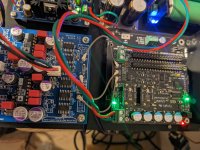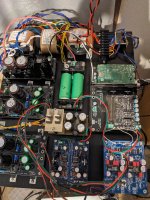IME, it would be the one farthest away and or most shielded from your dac. Reason is because at that point in the processing its just a computer. If not doing DSP it should have no effect no dac sound except to the extent it is a EMI/RFI noise source.Which rpi4b is recommended?
Regarding half measures, almost everything is something like that in reality. A system may fail completely, work perfectly, or be somewhere in between. If it doesn't fail completely, then its somewhere in between because there is no such thing as perfection in music reproduction. IMHO especially not for dacs and not for speakers.
I only worry about what I can control. Technology is so good nowadays, I don't worry too much about wear and tear as there's likely new iterations of products over time. So since you educated I on tin versus gold, I can control that in my chain. I can have a 98-99% confidence that I have taken all the right steps within my Goldilocks zone to simulate Music / Live Music to my satisfaction. There are no absolutes as it's just a simulation, so I just try to get as close to reality as possible not re-create reality itself.
Which rpi4b is recommended? Does the amount of memory matter? I am merely running a Roon endpoint.
For I, it's everything. I try to run my chain as barebones as possible so my filesystem loads completely in RAM. I can remove the physical boot USB stick and it will still run normally because it's all run within RAM. I've never touched Roon, but I imagine a Roon endpoint running completely in RAM would be pretty nice. My music player has the ability to configure running in RAM as well. If you are running just a generic laggy Linux OS, YMMV.
So I'm hoping RPi5 will have at least 16GB. For now 8GB does the job and it's not much more in price than a 4GB. It also seems like the 8GB is the easiest to pickup right now as it pops up in stock randomly every week at a US Retailer. For I, you can never have enough RAM.
The Music Servers running from $10-40K have this RAM ability along with low latency realtime kernels, so I'm fortunate to be able to replicate these abilities on a RPi at a fraction of the cost with my own power supply preference. No noisy Mains as you would find on the uber expensive Music Servers.
I do the same on my PC as I also have a low latency realtime OS that completely loads in RAM for gaming. So because I have 32GB, I can completely load the game in RAM. I enjoy this very much with my FPGA DAC as I can listen at low volumes with all the details, imaging and zero noise floor. I wish to upgrade to Apacer RAM (Audiophile RAM) one day on my PC and I definitely wish I would be able to upgrade the RAM on RPi too. There are reports of RPi RAM upgrades, but it's only from 1GB to 8GB. They either did not have the ability to get a 8GB because of supply chain issues or they are correcting their mistake and now upgrading to 8GB. But these reports are for general use, not audio.
Anyways, good luck. I'll check back here in August. Just making a pit stop because I thought that tin versus gold was interesting and something I never considered for pin communication.
Last edited:
IOW, if it's worth doing, it's worth doing right.
And many of us have Ian to thank for making it possible to do the right thing. Cmon, Ultra capacitors as the foundation for one's audio system. 3000 Farad, 9000 Farad? Ridiculous. UcBalancers, State of the Art Clocks, LifePO4, etc. Components I would of never imagined to empower one to make it worth doing right. I'm 100% a completely Off Mains, Pure Mode, dude and never thought I would reach this goal without a car battery / battery rig. Super, super low impedance throughout the chain.... Super pure mode... DIY-friendly for simpletons like I.... list goes on....
As I understand it, my actual Roon server does all the heavy lifting and rendering etc. The Roon server pre loads the track into RAM. Eventually it pipes out the music via its raat (or something like that) protocol over your network down to the Roon endpoint of your choice. All the endpoint needs to do is run a tiny piece of software called roon bridge.For I, it's everything. I try to run my chain as barebones as possible so my filesystem loads completely in RAM. I can remove the physical boot USB stick and it will still run normally because it's all run within RAM. I've never touched Roon, but I imagine a Roon endpoint running completely in RAM would be pretty nice. My music player has the ability to configure running in RAM as well. If you are running just a generic laggy Linux OS, YMMV.
So I'm hoping RPi5 will have at least 16GB. For now 8GB does the job and it's not much more in price than a 4GB. It also seems like the 8GB is the easiest to pickup right now as it pops up in stock randomly every week at a US Retailer. For I, you can never have enough RAM.
The Music Servers running from $10-40K have this RAM ability along with low latency realtime kernels, so I'm fortunate to be able to replicate these abilities on a RPi at a fraction of the cost with my own power supply preference. No noisy Mains as you would find on the uber expensive Music Servers.
I do the same on my PC as I also have a low latency realtime OS that completely loads in RAM for gaming. So because I have 32GB, I can completely load the game in RAM. I enjoy this very much with my FPGA DAC as I can listen at low volumes with all the details, imaging and zero noise floor. I wish to upgrade to Apacer RAM (Audiophile RAM) one day on my PC and I definitely wish I would be able to upgrade the RAM on RPi too. There are reports of RPi RAM upgrades, but it's only from 1GB to 8GB. They either did not have the ability to get a 8GB because of supply chain issues or they are correcting their mistake and now upgrading to 8GB. But these reports are for general use, not audio.
Anyways, good luck. I'll check back here in August. Just making a pit stop because I thought that tin versus gold was interesting and something I never considered for pin communication.
Currently I just use an rpi4b that runs something called VitOS, which does nothing else but run roon bridge. In current form it’s recommended to go super low on rpi ram (1-2gb) because VitOs just won’t use it because all the lifting is on the server. So in theory ???? This would still apply?
Hello,
I asked Ian but no reply so far.
I am going to build a new Q7 and i know the 5 volt side takes about 60 mA on average.
I already have a two year old 5 conditioner that i could use unless the new one offers a real advantage.
I could use the linearpi solo MK2 5 volts
I wanna use a choke input but choice could be limited because the ultracaps are taking considerable current during charging. I wanna know how much current that would be to be able to chose the right choke.
I have a 1000mH choke that would saturate well above 1A but my idea would be that a higher Henry choke would work better but then that one would saturate at a lower current. If the charging proces will be done at a lower current i could get myself a choke that could be 4000mH, same DCR but saturating at 250 mA. Close to saturation inductance could suffer but once the ultracaps are loaded and average current is 60 mA the choke will work perfectly.
Any suggestions on how to proceed? thanks in advance, Eduard
I asked Ian but no reply so far.
I am going to build a new Q7 and i know the 5 volt side takes about 60 mA on average.
I already have a two year old 5 conditioner that i could use unless the new one offers a real advantage.
I could use the linearpi solo MK2 5 volts
I wanna use a choke input but choice could be limited because the ultracaps are taking considerable current during charging. I wanna know how much current that would be to be able to chose the right choke.
I have a 1000mH choke that would saturate well above 1A but my idea would be that a higher Henry choke would work better but then that one would saturate at a lower current. If the charging proces will be done at a lower current i could get myself a choke that could be 4000mH, same DCR but saturating at 250 mA. Close to saturation inductance could suffer but once the ultracaps are loaded and average current is 60 mA the choke will work perfectly.
Any suggestions on how to proceed? thanks in advance, Eduard
Hello,I am building ad1862 dac with FifopiMA.
But music never came out yet.
I connected Bck,LRck,Data with SCK,LR/DO,SD/D1 and fifopi looks working ok.
Are there anything I need to change settings or It might be DAC problem.
But music never came out yet.
I connected Bck,LRck,Data with SCK,LR/DO,SD/D1 and fifopi looks working ok.
Are there anything I need to change settings or It might be DAC problem.
Attachments
I have powered 5v both rpi and fifopima.
Since I have connected with isolator pi, I left fifopima j4 1-2 3-4 shorted.
Fifopi led seems ok.when I play music on,green led lit.
But still no sound.
Then I changed dac board,but also no sound.
I will check everything again.thank you for help anyway.
Since I have connected with isolator pi, I left fifopima j4 1-2 3-4 shorted.
Fifopi led seems ok.when I play music on,green led lit.
But still no sound.
Then I changed dac board,but also no sound.
I will check everything again.thank you for help anyway.
How did you set "audio output" in RPi's player software ? it should be " hifiberry dac+" ...Yes,I read.
It's difficult for me but I am learning.
- Home
- Source & Line
- Digital Line Level
- Asynchronous I2S FIFO project, an ultimate weapon to fight the jitter

